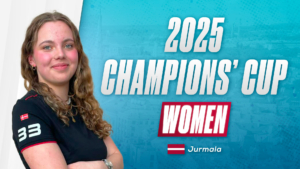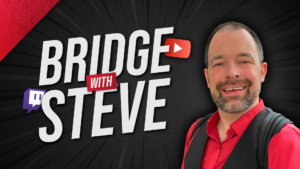
2024 Israeli Open Team Trials

Who said that only grand champions could write bridge articles? Funbridge has launched a new format of articles that allow talented players to share their expertise on the deals that inspire them the most. We have the pleasure of presenting you with a captivating article below that was written by one of the members of our community.
Zoom in on the author
Yoram Aviram is an experienced bridge player and a former member of the Israeli Junior and Open teams with several achievements on the national and international scenes.
Yoram left the game many years ago to focus on family and work (in the field of computerised trading of financial instruments) and switching hobbies from the mind sport of bridge to the physical sport of competitive road cycling.
After returning to his old passion and adopting Funbridge as the platform on which to refresh his old skills, he is now back on the Israeli Open team heading to the 2024 European Championships in Denmark.
He is happy to share deals of particular interest with the Funbridge community on the blog.

2024 Israeli Open Team Trials
About 20 years have passed since I had the privilege of being on the Israeli national team, representing my country at international championships. Life circumstances took me away from the game in favour of work, family and other hobbies. Around 2 years ago the old « bridge bug » bit me again and I returned to competitive bridge. Since then, it has been my dream to reach the top and return to the national Open team.
This year the trials were a 2-stage pairs tournament. 15 pairs competed at the early stage with 5 qualifying for the final one. In the final those 5 pairs were joined by 3 pairs who were exempted from the early stage. The top 2 pairs from the final would make it to the team and would be joined by a top pair who didn’t have to go through the trials.
We managed to qualify for the final stage relatively easily. The final was played over a 4-day-long weekend in mid-January. The scoring system used was IMPs across the field in a double round robin with 14 boards in each match.
Although being highly motivated, my partner Gilad and I realistically felt that our chances of reaching one of the top 2 spots against 7 of the top Israeli bridge pairs, most of them younger and better trained than us, were quite low. However, we had experience and an excellent partnership spirit on our side.
Thus, on a bright Wednesday the final commenced. During the first 3 days, we were mostly placed slightly above average, which put us in a potentially qualifying position since, as expected in such a strong field, no great gaps were opened.
Come the next-to-last match started, we were ranked 5th, with around 10 VPs from second place (Matches were scored by splitting 20 VPs), so we needed 2 good matches to have a qualifying chance.
The first deal of the match was not good for us, failing to double opponents in a 5 Club contract, down 2, with 4 Hearts making for our side.
The second deal seemed flat, opponents going down in a normal 3NT contract.
The following is the third hand:
Sitting East, I held the following cards.

We were vulnerable. LHO opened 1♣, Partner overcalled 1♠, RHO bid 2♥, I passed and LHO jumped to 3NT and RHO, Michael Barel (my partner of 20 years old) after pausing for some thought, jumped to 6♥!
All passed and my first decision was the lead. I asked Michael about the meaning of his partner’s 3NT. He said that it was just better than 2NT. I assumed that LHO who had opened 1♣ had a good ♣ suit. My K was well placed for Declarer, so an aggressive lead was in order. Should I lead Partner’s suit or maybe the ♦A? The diamond lead seemed a better option, since for his bid, Declarer should be prepared for a spade lead. A diamond lead might work if Partner had either the ♦K or a diamond singleton. Accordingly, I led the ♦A and Dummy’s cards were spread:

I was sure that the dummy was weaker than what Declarer expected, so we might have a real chance. A small diamond was played from the dummy and Partner dropped the J, Declarer following.
It seemed that the lead dilemma was still on. Those Clubs in Dummy might give Declarer his 12 tricks unless we first took 2. So, the question remained: could Partner have the ♠A? Could he have the ♦K or a diamond singleton? Partner’s J play was consistent with an aggressive spade suit preference signal, but also with a holding of KJ or, obviously, a singleton.
Why did Michael jump to 6♥ and didn’t he ask for aces? I was sure that the reason was that a 4NT bid by him over Partner’s 3NT would be a « quantitative » invitation, so he probably had no ace-asking bid available. Despite Michael’s strong bid, Partner did overcall a vulnerable 1♠, so he too should have some values, either the ♠AK, or the ♠A and ♦K. With a 7-card suit, he would likely have bid 2♠ or 3♠, so Declarer was probably not void in Spades. Let’s try to construct a couple of possible hands for Declarer to see what was likely.
This hand, I believe, was possible:
♠ A
♥ A K Q 10 x x x
♦ x x x
♣ x x
It is quite a strong hand, leaving Partner with just enough for an overcall and with no Blackwood available a 6♥ bid is a reasonable gamble. Obviously, with that hand, a Diamond continuation is essential. Unless we immediately cash our 2 Diamond tricks, Declarer will throw his 2 diamond losers (after finessing twice, over and over a spade after the marked ruffing finesse). (Note: Partner’s J♦ play was forced.)
Here was another possible hand:
♠ x
♥ A K Q 10 x x x x
♦ K x
♣ x x
Hight-cards-wise, it is a weaker hand, but the 8-card suit compensates. Here, of course, I should switch to a spade (which Partner cried for with his ♦J play).
I was really lost. It was a critical card of a critical hand of a critical match of a critical tournament. It was likely to decide if we would make it to the team and it seemed to just depend on a guess. It really felt funnily unfair. I just felt like laughing, which I actually did, and so, I thought to myself that Michael was more likely to gamble a slam, holding two Aces rather than just one and I continued with a Diamond…
I immediately felt a bad vibration from across the table. Dummy’s Q was played, Partner played the lowly 2 and Michael (exhaling with relief, or did I imagine?) took with the K.
Oops… I badly blundered. Declarer drew a trump and played a Club. I had a slight hope that maybe he had a singleton club and would try ruffing finessing Partner, but, with a shrug, he asked for Dummy’s Q and continued to draw trumps, finessed Clubs again and discarded a spade loser on the ♣A (he actually held the second hand above).
Michael continued to claim the rest. In anticipation of Partner’s coming reaction, as a low grumble began to form from his side of the screen, quickly, before the table rose towards me, I lowered my head under the screen and said « Sorry Partner, I played you for KJ of Diamonds »… The table was lowered, some mumbling unhappy sounds were still heard, but slowly faded away…
That seemed to be it. Our chances of joining the team were practically gone. Bridge is so unfair! Should have played chess, such a beautiful AND FAIR game…
As it turned out, we prevailed. The rest of the match was favorable and the last match was very good for us. We finished second and made it to the Open team! Our teammates Birman-Padon and Zamir-Toledano are two young, very nice and strong pairs. We hope to contribute our part. After 20 years, I am again going to represent Israel at the European Championships!
To view the results in the language of your choice, a tick at the top right of your screen will automatically translate them for you.
What is the concept behind community articles?
Would you also like to write an article? At Funbridge, we like to give our players a voice. In this format of articles, it is you who write the content. If you notice a deal that you find particularly interesting and that you would like to share with the Funbridge community, tell us in a comment below! We will get back to you quickly.

Content Manager
What did you think of this article?
Share your opinion in the Comments section below.




Great article. Nice to read something where not everything goes according to plan but still has a happy ending.
Relief that champion bridge player admits to getting it wrong! My problem is my p is never wrong, & always discusses boards at the end of each hand ! this embarasses me & I ask to leave discussions till end of round. I always quote Larry’s advice , “your p is not your teacher “ . Ho hum!
Great hand – I especially can relate when, for all your skill and experience, a critical decision seems to be a complete guess between two or more alternatives. Those positions are excruciating!